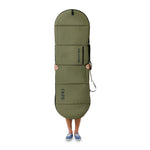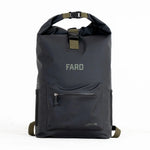
If you’ve just added a new surfboard to your quiver, your next move should be to protect it. A surfboard bag isn’t just a nice-to-have accessory—it’s an essential piece of gear that ensures your board stays safe from cracks, dings, and unnecessary wear and tear.
But with so many different types, styles, and materials to choose from, figuring out which surfboard bag is right for you can feel overwhelming. Should you go minimalist with a surfboard sock? Is a travel bag too much unless you’re flying overseas? This guide will answer all those questions and help you find the ideal protection for your board.
We’ll break down the different types of surfboard bags, how to choose the right size, what materials to look for, and how to avoid common buying mistakes. By the end of this post, you’ll know exactly what type of surfboard bag fits your lifestyle—and why FARO board bags are built to meet every need.
Why Every Surfer Needs a Surfboard Bag
No matter your level of experience or how often you surf, board protection is non-negotiable. A surfboard bag shields your board from the elements, day-to-day bumps, and accidental damage during transport. Without a bag, even a short drive to the beach or a walk down the sidewalk can lead to costly damage.
On top of that, a bag keeps your board out of direct sunlight, protects wax from melting, and prevents UV exposure that can yellow or degrade the fiberglass. If you're a traveling surfer, a surfboard bag becomes even more critical—especially when your board is at the mercy of baggage handlers, conveyor belts, and tight luggage compartments.
The right board bag not only protects your investment but gives you peace of mind. Whether you're heading down the road or across the world, it ensures your board arrives ready to ride.
Find Your Perfect Bag → Shop FARO Board Bags
How to Choose the Right Surfboard Bag
Before diving into the different types of surfboard bags, it’s important to consider your specific needs. How often do you travel? What kind of waves are you chasing? How many boards are in your quiver?
Use Case: Daily Surf vs. Travel Adventures
-
For daily surf sessions or short weekend road trips, you’ll want something lightweight and easy to carry. A board sock or day bag typically offers enough protection for your everyday routine.
-
For long-haul trips or air travel, you’ll need extra durability and padding to protect your boards from rough handling. This is where a travel or coffin bag becomes essential.
Your lifestyle and surfing habits are the biggest factors in determining which bag makes the most sense.
Sizing: Why Length and Width Both Matter
Once you know the type of bag you need, the next step is choosing the correct size. A common mistake surfers make is only looking at the length and forgetting about the width.
-
For day bags, match the bag length to your board. It’s best to buy a bag that’s 2–3 inches longer than your board so you don’t have to take off your fins.
-
For travel bags, go 3–4 inches longer than your longest board to allow space for padding and multiple boards.
-
For board socks, a snug fit is okay since they stretch, but still make sure the sock isn’t too short.
Also, not all 6’0” bags are created equal. Some bags are exactly six feet, meaning you may need to remove your fins—even if your board is 5'11". FARO board bags are designed with a fin-compatible system, so you don’t have to keep removing and reinstalling your fins every session.
And don’t forget width. If you're riding a wide fish or funboard, a narrow bag may not fit properly. Always check both length and width specifications before purchasing.

Materials: What Your Surfboard Bag Is Made Of
Different types of board bags are made from different materials, and each material offers varying levels of protection and durability.
-
Cotton Canvas: Durable and rugged. Often used in socks or canvas bags. It’s breathable, but often not waterproof.
-
Polyester Canvas: Common in day bags, board socks, and travel bags. Lightweight, water-resistant, and usually comes with UV-resistant coatings.
-
Tarpaulin: Lightweight, and waterproof but often not very durable or long lasting in the sun.
-
Stretch Knit: Sometimes made of cotton, polyester, or various blends. Stretchy but not waterproof.
Each material serves its purpose based on how often you use your bag and the level of protection you need.
From Socks to Travel Bags – Explore the Full Lineup
The Main Types of Surfboard Bags
Let’s explore the most common surfboard bag options available today—and which one is best for you.
Day Bags: Everyday Protection for Everyday Surfers
A day bag is your go-to option for protecting your board from daily wear and tear. Whether you’re heading to a dawn patrol session or cruising to your local break on the weekend, a day bag shields your board from the small accidents that can happen along the way.
These bags are designed to guard against scratches, car dings, and UV exposure. Most feature a zipper closure, but FARO offers a canvas day bag that is equipped with a roll-buckle closure system that won’t jam or break under pressure. FARO also has a zippered padded day/travel bag for more protection.
They’re ideal for:
-
Local surfers who drive to their break
-
Roof rack or bike rack transport
-
Minimalist surf trips within driving distance
Typical cost: $100 to $200
For more detail, read our post: [Surfboard Socks vs. Bags – Which One Is Right for Your Board?]
Board Socks: Lightweight, Budget-Friendly Cover
Surfboard socks are a simple and affordable solution for light protection. Made from cotton-knit materials, they’re breathable and stretch to fit multiple board shapes and sizes.
They’re perfect for:
-
Storing your board at home
-
Walking to your local break
-
Shielding against sun damage and dust
While socks don’t offer much impact protection, they do help prevent wax transfer, sun yellowing, and superficial scratches. Most come with a drawstring closure rather than a zipper, which means fewer parts that can break.
Just be cautious—if you leave a bar of wax inside during a sunny day, it could melt all over your board.
Typical cost: $50 to $80
Travel Bags (Coffin Bags): Ultimate Protection for Big Trips
If you’re planning to fly with your boards or go on an extended surf trip, a travel bag is the best option. Also known as a coffin bag, this style is built with thick padding, multiple compartments, and sometimes even wheels to help you navigate through airports.
Travel bags are made to carry multiple boards and tons of gear, making them ideal for:
-
International surf trips
-
Long-distance road trips
-
Surfers traveling with multiple boards
They offer maximum protection, but can be bulky and heavier to carry. We recommend adding extra padding like towels or wetsuits for added peace of mind during flights.
Typical cost: $200 to $300
Mistakes to Avoid When Buying a Surfboard Bag
Even experienced surfers sometimes make simple mistakes when shopping for a board bag. Here are a few things to avoid:
-
Ignoring width: Make sure your board’s shape and thickness are compatible with the bag.
-
Buying too small: Leave enough room for fins, extra padding, and ease of use.
-
Assuming all 6’ bags are the same: Check the interior dimensions before you buy.
-
Overstuffing zippered bags: This can cause zippers to break. FARO’s roll-top design eliminates this issue.
-
Choosing price over durability: Skimping on protection can cost more in the long run when your board gets damaged.

When to Upgrade Your Surfboard Bag
If your current bag is showing signs of wear—broken zippers, thin padding, or fabric tears—it’s probably time to upgrade. The same goes if you’ve recently added new shapes to your quiver, or if your surfing habits have changed (like starting to travel more).
If you're moving from local breaks to far-flung destinations, your protection gear should evolve with you.
Looking for your next adventure? Check out our blog on [Eco-Friendly Surf Resorts Around the World] for surf destinations that match your values.
Why FARO Surfboard Bags Are Built for Real Surf Travel
At FARO, we design surf gear based on real-life needs. Our board bags are built to handle daily use, rough travel, and everything in between.
What sets FARO bags apart?
-
Fin-compatible design: No need to remove your fins
-
Roll-top closure: No zippers to jam or fail
-
Durable materials: Canvas, polyester, and eco-conscious construction
-
Thoughtful features: Handles, storage pockets, and reinforced seams
-
Lifetime Guarantee – FARO will repair, replace or refund your products for life.
Every bag we make is field-tested by surfers and crafted to last through heavy use. Whether you're just getting into surfing or you're on your fifth surf trip this year, we have a board bag that fits your needs.
Browse our full collection of board bags, including:
-
[Day Bags]
-
[Surfboard Socks]
-
[Travel Bags]
Final Thoughts: Choose the Surfboard Bag That Matches Your Journey
Your surfboard deserves proper protection. Whether you're paddling out every weekend or flying halfway across the world, there's a board bag that fits your life and your board.
-
Choose a board sock for casual use and short commutes.
-
Go with a day bag for everyday missions and moderate protection.
-
Invest in a travel bag for serious trips and full quiver coverage.
At FARO, we’re here to make sure your gear is safe so you can focus on the waves ahead. Explore our full range of bags and start your next journey with confidence.
FAQs





